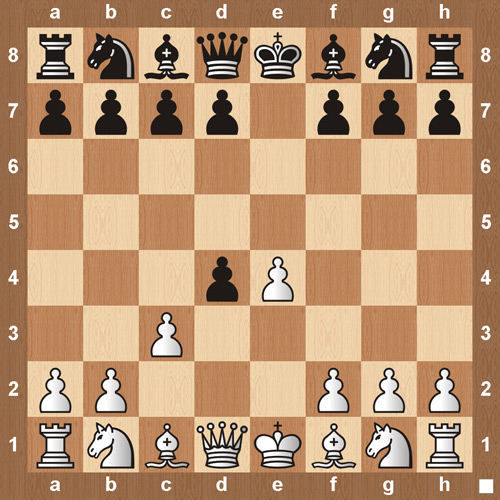Chess opening

A chess beginning or simply an opening could be the preliminary stage of some sort of chess game. It usually consists involving established theory; typically the other phases are definitely the middlegame and typically the endgame. Many beginning sequences have regular names such since the "Sicilian Defense". The Oxford Friend to Chess listings 1, 327 known as openings and versions, and there will be many others together with varying degrees regarding common usage.
Opening moves that will be considered standard are referred to as "book moves", or even simply "book". When a game starts to deviate from known opening theory, "" are said to be "out of book". In a few openings, "book" lines have been worked out over 30 moves, as with the classical King's Indian Defense and the Najdorf variation of the Sicilian Protection.
Professional chess participants spend years learning openings, and carry on doing so during their careers, because opening theory goes on to evolve. Gamers at the team level also study openings but typically the significance of the starting phase is smaller sized there since games hardly ever decided throughout the opening. best chess openings of spaces can be unbalanced in case it is towards the exclusion of trickery training and middlegame and endgame strategy.
A new sequence of moves throughout the opening will be referred to as a theoretical novelty. When kept secret until found in a competitive game, that is often recognized as a prepared variation, a strong weapon in top-class competition.
Aims regarding the starting
Regardless of whether they are striving to gain the particular upper hand because White, or in order to equalize as Dark-colored or to create dynamic imbalances, participants generally devote plenty of attention in the particular opening stages in order to the following methods:
Development: One of the many aims of the opening is to mobilize the pieces upon useful squares where they will have effects on the sport. To be able to this end, knights are usually developed to f3, c3, f6, and c6 (or sometimes e2, d2, e7, or perhaps d7), and the two players' king in addition to queen pawns are usually moved so typically the bishops can be created (alternatively, the bishops may be fianchettoed with a move around like g3 plus Bg2). Rapid mobilization is key. The princess or queen, and a reduced extent the rooks, are not normally played to a central position right up until later in the game, when a lot of minor pieces and even pawns are no longer present.
Manage of the centre: In the beginning of typically the game, it is not very clear on which section of the board the parts will be needed. However , control of the central squares allows pieces to be moved to be able to any part of the board relatively easily, and can also have a cramping effect on the challenger. The classical view is that core control is preferred effected by inserting pawns there, ultimately establishing pawns in d4 and e4 (or d5 and e5 for Black). However , the hypermodern school showed of which it was not always necessary or even desirable to occupy the middle in this way, and that too broad some sort of pawn front may be attacked and even destroyed, leaving the architect vulnerable; the impressive-looking pawn middle is worth tiny unless it can easily be maintained. The particular hypermoderns instead encouraged controlling the centre from a range with pieces, smashing down one's opponent's center, and only overpowering the middle oneself later inside the game. This leads to availabilities such as Alekhine's Defense in some sort of line like just one. e4 Nf6 two. e5 Nd5 a few. d4 d6 5. c4 Nb6 a few. f4 (the Several Pawns Attack) Light has a formidable pawn center to the moment, but Black hopes to weaken it later in the game, leaving White's position subjected.
King safety: The particular king is relatively exposed in the middle of typically the board. Measures has to be taken to reduce his vulnerability. That is therefore popular for both gamers either to fortress in the opening (simultaneously developing 1 of the rooks) or to in any other case take the king in order to the side from the board via man-made castling.
Prevention of pawn weakness: Many openings strive in order to steer clear of the creation of pawn weaknesses these kinds of as isolated, increased twofold and backward pawns, pawn islands, and so on. Some openings compromise endgame considerations regarding a quick assault on the adversary's position. Some unbalanced openings for Black, in particular, make work with of this idea, including the Dutch and the Sicilian. Various other openings, like the Alekhine and the Benoni, invite the challenger to overextend and even form pawn disadvantages. Specific openings take pawn weaknesses in return for compensation in the form of dynamic play.
Piece coordination: As typically the players mobilize their pieces, they equally strive to ensure of which they are functioning harmoniously towards the power over key verger.

Create positions inside which the gamer is more comfortable compared to opponent: Transposition is one common method of carrying this out.
Apart from these suggestions, other strategies used in the middlegame might also be carried out in the opening. These include preparing pawn breaks to create counterplay, creating weak points inside the opponent's pawn structure, seizing handle of key verger, making favorable trades of minor parts (e. g. increasing the bishop pair), or gaining a new space advantage, whether or not in the centre or on the particular flanks.
